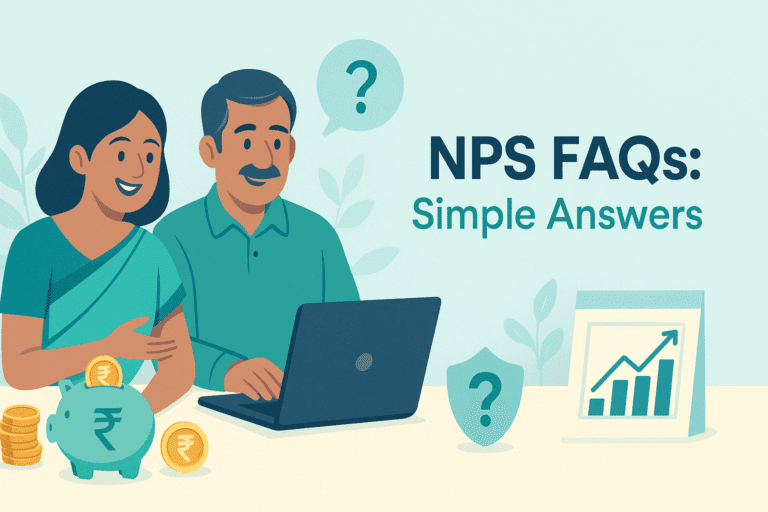NPS for government employees: Benefits, rules & guide

If you’re a government employee in India, understanding how the NPS for government employees works can help you build a solid retirement plan and save more on taxes. Whether you’ve just joined service or are in the middle of your career, this guide will explain everything in simple language — no confusing terms, just clear answers.
The national pension system (NPS) is a retirement savings scheme handled by the Government of India. For government employees who joined on or after January 1, 2004, NPS is mandatory. Unlike the old pension scheme, NPS helps you grow your retirement savings over time by investing in a mix of assets.
So, if you’re working in central or state government services, NPS is likely already a part of your monthly salary structure.
Who Is Covered Under NPS in Government Jobs?
Here’s who is automatically enrolled:
- Central Government employees (except Armed Forces) who joined on or after Jan 1, 2004
- State Government employees where the state has adopted NPS
- Staff of autonomous bodies under central or state governments, if included under NPS
So, if you’ve joined a government job recently, there’s a good chance you’re already contributing to NPS.
Contribution Rules: How Much Do You and the Government Pay?
As a government employee, your NPS account is funded every month in this way:
| Contributor | Contribution (Based on Basic + DA) |
| You (Employee) | 10% |
| Government (Employer) | 14% |
That’s right — the government puts in more than you do. This 14% employer contribution is a big benefit and one of the reasons NPS is such a powerful savings tool.
Tax Benefits: Save More Than ₹2 Lakh Per Year
One of the biggest advantages of NPS is the tax saving you get. Here’s how you benefit:
1. Section 80C
You can claim up to ₹1.5 lakh along with other investments like LIC, PPF, etc.
2. Section 80CCD(1B)
You get an extra ₹50,000 deduction, specifically for NPS contributions. This is over and above 80C.
3. Section 80CCD(2)
You can also claim the government’s 14% contribution as a separate deduction — this is not counted in the ₹1.5 lakh limit.
Total possible deduction? ₹2 lakh or more every year! That’s serious savings on your taxable income.
What Happens to the Money You Contribute?
Each month, your contribution and the government’s share go into your Tier 1 NPS account. This money is invested by professional fund managers into a mix of:
- Equity (E) – for higher returns
- Corporate Bonds (C) – for moderate risk
- Government Securities (G) – for safety
Government employees usually have limited equity exposure to reduce risk. But over time, the fund grows with compound returns, giving you a strong retirement corpus.
Expected Returns from NPS for Government Employees
Unlike fixed pensions of the past, NPS returns are market-linked. This means your returns may vary depending on how markets perform, but historically:
- Average returns are around 8–10% annually
- Fund management fees are very low (around 0.01%), which helps your money grow more
Over the years, this can make a big difference in how much you receive at retirement.
What Happens When You Retire?
When you turn 60, here’s what happens with your NPS savings:
- 60% of the total amount can be withdrawn as a lump sum — and it’s tax-free
- 40% must be used to buy an annuity, which gives you a monthly pension (this part is taxable)
You can also delay your withdrawal until the age of 75, giving your money more time to grow if you don’t need it right away.
Early Exit or Withdrawal: What You Need to Know
If you leave your job or want to exit NPS before 60:
- You must use 80% of your corpus to buy an annuity
- Only 20% can be withdrawn as a lump sum
However, you can also partially withdraw up to 25% of your contributions (after 3 years) for specific reasons like:
- Medical treatment
- Child’s education or wedding
- Buying or building a house
How to Track or Manage Your NPS Account
You can monitor your NPS account using:
- NSDL CRA website – https://cra-nsdl.com
- Check contributions, returns, and fund allocation
- Download annual statements for tax filing
Make sure your mobile number and email are linked for regular updates.
NPS vs Old Pension Scheme: What’s the Difference?
| Feature | NPS | Old Pension Scheme |
| Who contributes? | You + Government | Only Government |
| Monthly pension guaranteed? | No (market-based) | Yes (fixed pension) |
| Portability | High – across jobs and states | Low |
| Tax Benefits | Up to ₹2 lakh+ per year | Limited |
| Ownership of funds | Yes (you can see and track your money) | No (pension is paid out) |
While the old pension scheme gave a fixed income, NPS offers ownership, flexibility, and growth potential, with higher tax benefits.
Final Thoughts: Is NPS Good for Government Employees?
Absolutely. If you’re a government employee, NPS gives you:
- A strong monthly contribution from the government
- High tax savings every year
- Long-term growth of retirement savings
- Portability if you switch departments or states
- Transparency through online access
It may not offer a fixed pension, but NPS helps you build a large, tax-efficient retirement fund over time — and that’s powerful.
Start checking your NPS account today, and understand how much you’re building for your future. The earlier you get familiar with it, the better control you’ll have over your retirement.
Other NPS related posts:
National Pension System (NPS) FAQs: Simple Answers
NPS Tax Benefits Explained: Save Up to ₹2 Lakh with India’s Top Retirement Scheme





